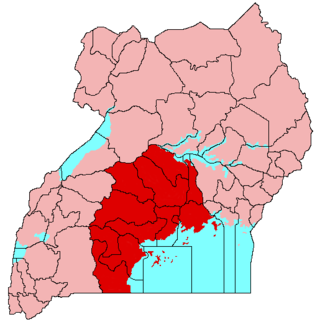
Buganda is a Bantu kingdom within Uganda. The kingdom of the Baganda people, Buganda is the largest of the traditional kingdoms in present-day East Africa, consisting of Uganda's Central Region, including the Ugandan capital Kampala. The 14 million Baganda make up the largest Ugandan region, representing approximately 16% of Uganda's population.

Mbarara District is a district in South Western Uganda. In 2019, the Ugandan Cabinet approved part of Mbarara District, the then-Mbarara municipality, to be upgraded to city status effective July 2020.

Kiboga District is a district in the Buganda Region of Uganda. The town of Kiboga is the site of the district headquarters.

Mubende is a district in the Central Region of Uganda. The town of Mubende is the site of the district headquarters. The district was reduced in size in July 2005 with the creation of the Mityana District and reduced again in 2019 when Kassanda District was carved out of it.

Hoima District is a district in Western Uganda. Like most other Ugandan districts, it is named after its main municipal centre, Hoima.

Kibaale District, is a district in the Western Region of Uganda. The district headquarters are in the town of Kibaale.

Masindi District is a district in Western Uganda. Like many other Ugandan districts, it is named after its 'chief town' of Masindi, the location of the district headquarters.
The Luweero Triangle, sometimes spelled Luwero Triangle, is an area of Uganda north of the capital Kampala, where, in 1981, Yoweri Museveni started the guerrilla war that propelled him and his National Resistance Movement into power in 1986.
Hoima is a city in the Western Region of Uganda. It is the main municipal, administrative, and commercial center of Hoima District. It is also the location of the palace of the Omukama of Bunyoro.
Kiboga is a town in the Buganda Region of Uganda. It is the main municipal, administrative, and commercial center of Kiboga District, and the district headquarters are located there.
The Anglican dioceses of Buganda are the Anglican presence in the Central Region, Uganda ; they are part of the Church of Uganda. The remaining dioceses of the Church are in the areas of Eastern Uganda, of Northern Uganda, of Ankole and Kigezi, and of Rwenzori.
Articles related to Uganda include:

Buliisa District is a district in Western Uganda. As with most Ugandan districts, Buliisa District is named after its "main town" Buliisa, where the district headquarters are located. Bugungu has 6 sub counties: Kigwera, Ngwedo, Buliisa, Butiaba, Kihungya, and Biiso. It also contain 3 town councils: Buliisa, Butiaba and Biiso.
Kyankwanzi is a District in Buganda Region of Uganda. It is one of the major political and economic centres of Kyankwanzi District and the district headquarters are located in Butemba Town Council.
Buloba is an urban area in Wakiso District in the Buganda Region of Uganda. The area is primarily a middle-class residential neighborhood.
Bukomero is a town in Ssingo County, Kiboga District, in the Central Region of Uganda.
Kiboga General Hospital, also Kiboga Hospital, Kiboga Main Hospital or Kiboga District Hospital, is a hospital in the Central Region of Uganda.
Albert Edward Baharagate Akiiki was a Ugandan Roman Catholic priest who served as Bishop of the Roman Catholic Diocese of Hoima. He was appointed bishop of Hoima on 7 July 1969 and he resigned on 9 March 1991.

The Biharwe Eclipse Monument aka 1520AD Biharwe Eclipse Monument is a monument that was built in commemoration of the total eclipse of the sun which took place on April 17, 1520. It is located in Biharwe town in Mbarara District, Uganda.










